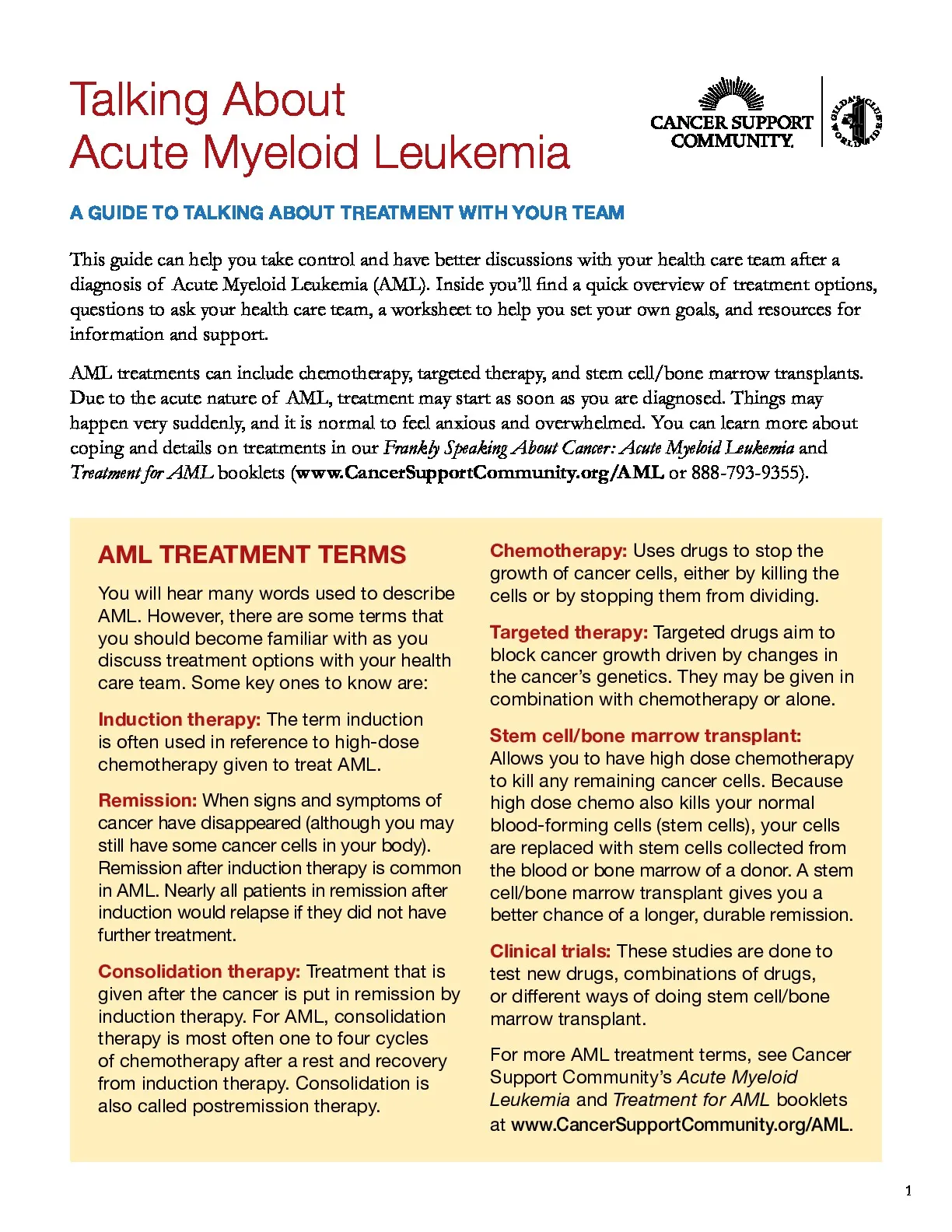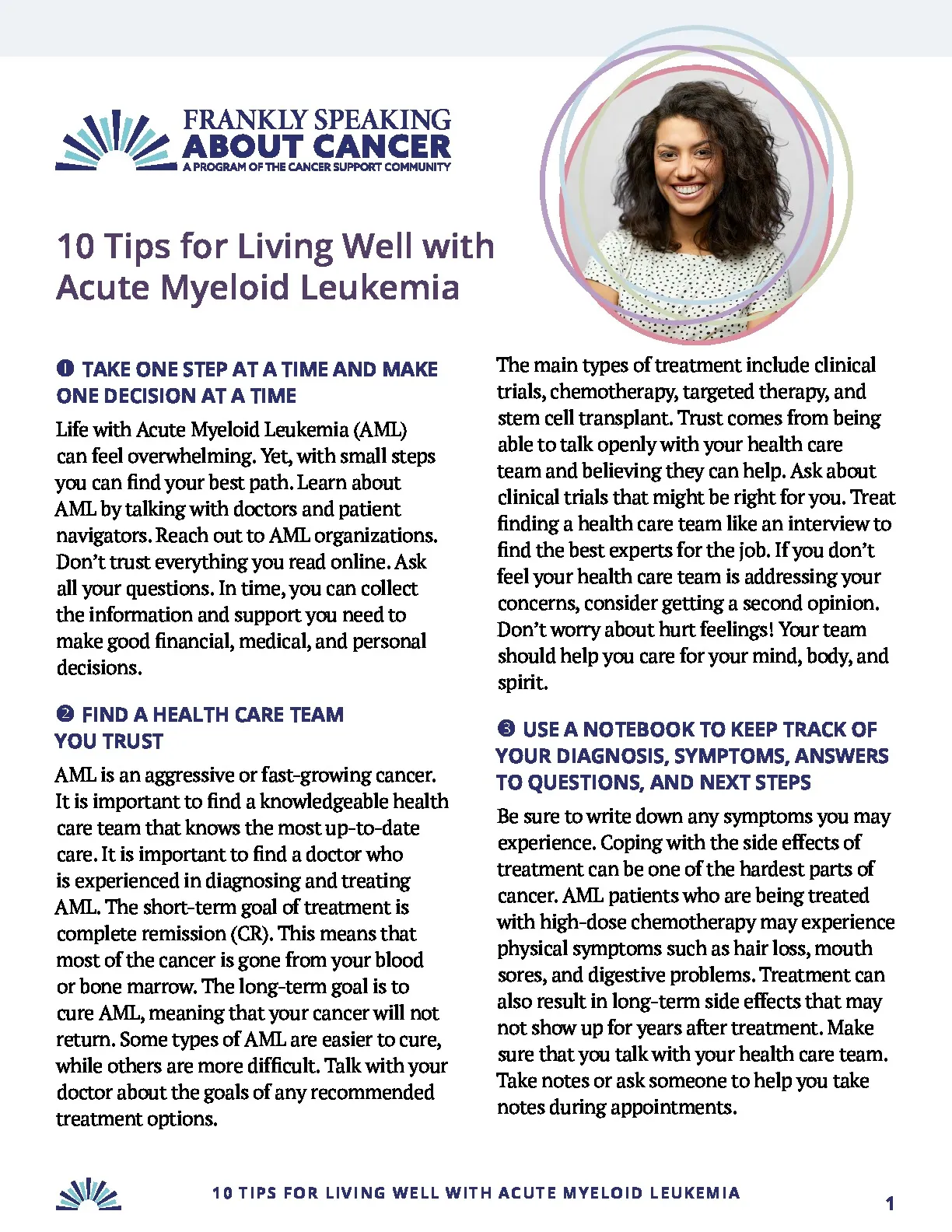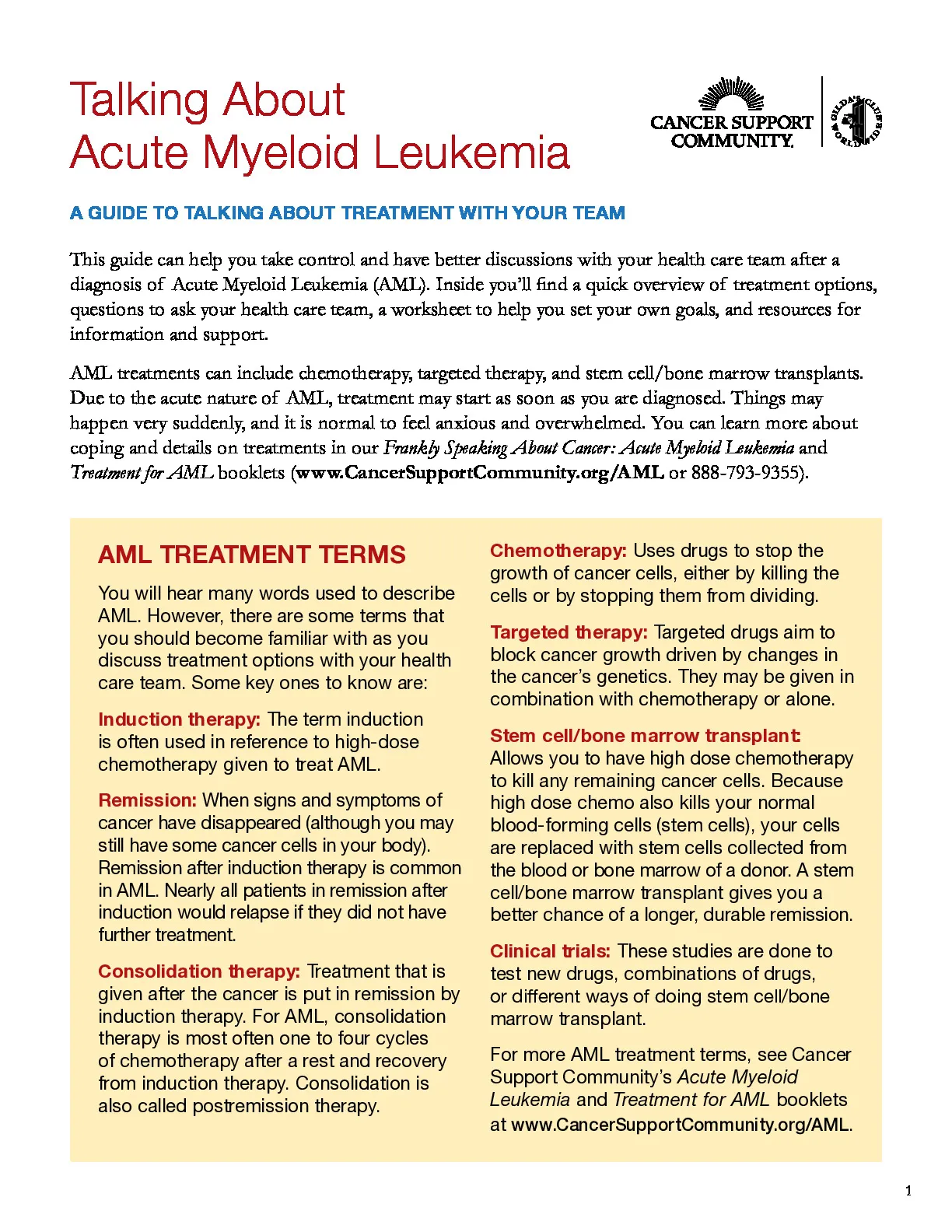Acute Myeloid Leukemia
Table of Contents
AML begins in the bone marrow, the soft inner part of certain bones, where new blood cells are made. Changes happen in some of these cells that make them grow out of control. AML usually grows and moves into the blood quickly.
Talking About AML
You will hear many words used to describe AML. Some key ones to know are:
Develops quickly. If not treated immediately, will progress rapidly and likely be fatal.
Short for “myeloblasts.” These are the immature blood-forming cells that normally appear in bone marrow. AML occurs when a blast is “stuck” in its immature state and multiplies.
A cancer of the blood cells, which grow out of control and crowd out healthy cells.
Describes the type of cells that would normally turn into more specific, mature kinds of white blood cells, red blood cells, or platelets.
When leukemia reappears in the marrow after treatment.
Risk Factors, Signs & Symptoms
There isn’t a known cause for most cases of AML, but research has shown that some things may increase your risk. These risk factors include: exposure to certain chemicals (such as benzene), smoking, and some genetic disorders or family history of leukemia. AML is sometimes a secondary cancer caused by radiation or chemotherapy for other cancers.
Diagnosis
If your doctor suspects AML, they will order tests, including:
Blood tests — specialized test to determine how many white blood cells you have and to see if these cells look abnormal. For information on normal results for Complete Blood Count (CBC) tests, visit www.CancerSupportCommunity.org/CBC.
Bone marrow biopsy/aspiration — These tests take both solid and liquid portions of the marrow, usually from the pelvis. If 20 percent of the cells in the bone marrow are immature “blast” cells, the diagnosis is usually AML. In normal bone marrow, the blast count is 5 percent or less.
Biomarker Tests
Biomarker tests can be used to diagnose the specific subtype of AML you have, if any. The results can help your doctors decide which treatments may work best against your specific type of AML. The three main types of tests that look at changes (“mutations”) in the cancer’s genes are:
- Cytogenetics (also called chromosome tests)
- Fluorescence in situ hybridization (FISH)
- Other molecular/genomic tests, such as:
- Polymerase chain reaction (PCR)
- DNA sequencing and microarray technologies
- Next generation sequencing – looks for a number of specific genetic changes to the cancer cells at once
Your doctors use these tests to look for mutations in the AML cells (changes in the cancer cell’s DNA). Nearly two-thirds of people with AML have these changes.
Biomarkers that can help your doctors decide your AML treatment include:
- FLT3 (pronounced “flit3”)
- IDH1 and IDH2
- p53 (TP53)
- NPM1
- CEBPA
Ask your doctor if you have been tested for these and other, newer biomarkers that may help decide which treatment is best for you.
Subtypes
AML is not just one disease. It is a set of diseases that are divided into subtypes. This information helps doctors to estimate how the disease will progress and what treatment will work best. Your doctor should tell you which subtype you have and which treatment is recommended.
Tips For Acute Myeloid Leukemia
Peter, who lives with AML, discusses tips for living with AML and how it changed his perspective on life.
Treatments
After you find out you have AML, your doctor will tell you which treatments are best for you. Your doctor may ask you what you want to do. This is called treatment planning. Due to the acute nature of AML, treatment may start as soon as you are diagnosed. There are often more treatment choices to be made after your first treatment is finished. For example, once you are in remission, you may have the option to get a stem cell transplant.
Some of the factors that help your doctor and health team decide what treatment to recommend include:
- Your values, goals, and preferences
- Your age
- Your overall health
- Your medical history
- The subtype of AML you have
AML is an aggressive cancer. If possible, you should have your treatments at a major cancer center or university hospital to find the most up-to-date care. Usually, the first goal of treatment is to get the patient into complete remission (CR). This means that most of the AML has been eliminated from the patient’s blood or bone marrow. The long-term goal is to cure the disease. A cure means that the cancer will never return. This can be difficult to determine because AML can return after many years. A complete remission (CR) is the first step toward a possible cure.
Treatment of AML for most patients includes 2 phases of chemotherapy: 1) remission induction or induction, and 2) consolidation or post-remission therapy. Chemotherapy drugs most often used to treat AML are a combination of cytarabine and anthracycline agents.
Whenever receiving any medication or treatments for your cancer diagnosis, it is critical that you speak with your healthcare team when you develop new symptoms or your current symptoms are worsening.
Review Your Treatment Options
There are 4 main types of treatment for AML.
Most people with AML will receive chemotherapy treatment. The first phase of chemotherapy is induction therapy. It will usually begin right away. The goal of induction therapy is to bring on (“induce”) a complete remission (CR). This means: You have less than 5% blast cells in your bone marrow, your blood counts have returned to normal (or mostly normal), and you have no signs or symptoms of AML. Getting to a complete remission can take 3 to 6 weeks.
Partial remission (PR) is when cancerous cells are reduced but still detectable. There are several chemotherapy drugs that may be used to treat AML. Two or more of these drugs are usually combined at a time. These drugs are given through an IV (into a vein) at the hospital. Younger patients can sometimes receive higher doses of these drugs than older patients can.
Targeted therapy may be an option for some patients at different points of their treatment. Some targeted therapies are used only based on the findings of biomarker tests, including genetic testing of your cancer cells. Others are helpful for most cases of AML, and do not require specific testing. Targeted drugs aim to block cancer growth “driven” by changes in the cancer’s genetics.
AML targets that have therapies currently are: FLT3 mutations, IDH1 or IDH2 mutations, Hedgehog signaling pathway, and proteins called BCL-2 and CD33. For some of these drugs you need to be tested for the target. Ask your healthcare team if you have been tested for all the targets that have current therapies, including FLT3, IDH1, or IDH2.
Your healthcare team may recommend a stem cell transplant (SCT). This treatment allows you to have high-dose chemotherapy to kill any remaining cancerous cells. Because high-dose chemo also kills your normal blood-forming cells (stem cells), those are replaced with stem cells collected from the blood of a donor.
Bone marrow transplant (BMT) is similar, but the donor’s stem cells are collected from their bone marrow. This process works best if only small amounts of leukemia remain. That’s why it often isn’t used as a first treatment. It is most often used after you have achieved remission, when your doctor thinks there’s a good chance the AML will come back. For patients who are healthy enough, a stem cell transplant can offer a chance for a much longer or permanent remission than chemotherapy alone.
Researchers are finding new ways to treat AML. This means that the rates of cure are improving. Still, much more research is needed to fully understand the disease and how best to treat it. A clinical trial may be the only way to get certain treatments, including some that are very promising.
Diagnosis, Transplant, and Hospitalization
Peter discusses his journey to being diagnosed with AML, his stem cell transplant, and recovery in the hospital.
Frankly Speaking About Cancer Library
LibraryWould you like a print copy of these educational materials?
We can mail our Frankly Speaking About Cancer pieces to you. Shipping is free for up to 20 pounds.




